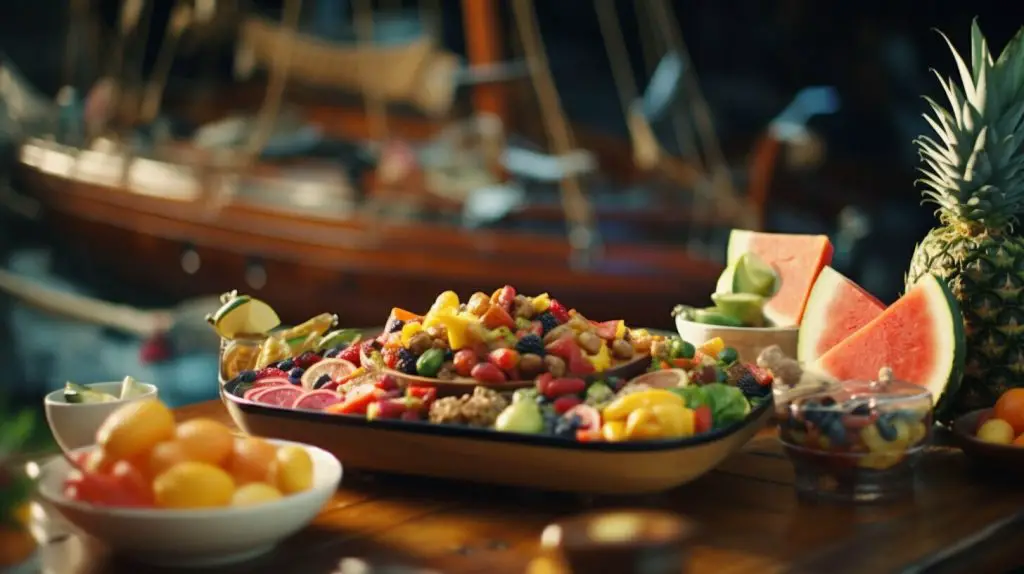Embarking on a sailboat trip is an exciting adventure that requires careful planning, especially when it comes to food. The right food can make or break your trip, so it's crucial to consider what to pack and how to store it. In this guide, we'll cover all the essentials to ensure that you have the best food to take on a sailboat trip.
From meal planning and food storage tips to delicious and nutritious food ideas, we've got you covered. We'll also discuss food preservation techniques to help you make the most of your provisions and answer some frequently asked questions about sailboat trip food. So, grab a pen and paper and get ready to discover the best food to take on your next sailing adventure!

Table of Contents
- Sailboat Trip Food Essentials: A Balanced Approach
- Delicious and Nutritious: Sailboat Trip Food Ideas
- Preserving the Goodness: Sailboat Trip Food Preservation Techniques
- FAQ - Sailboat Trip Food
Sailboat Trip Food Essentials: A Balanced Approach
Planning meals for your upcoming sailboat trip is crucial to ensure you have enough food for the duration of your trip. A balanced approach to meal planning is essential to provide your crew with the proper nutrition they need to stay energized and healthy. Here are some tips to help you plan and store food for your sailboat trip:
| Meal Planning | Food Storage Tips | Food Safety |
|---|---|---|
|
|
|
By following these meal planning, storage, and safety tips, you can provide your crew with delicious and nutritious meals while on your sailboat trip. A balanced approach to meal planning will help keep everyone energized and ready for whatever adventure comes their way.
Delicious and Nutritious: Sailboat Trip Food Ideas
When it comes to planning the food for your sailboat trip, it's important to think beyond just survival meals. With a little bit of creativity, your onboard meals can be both delicious and nutritious. Here are some ideas to get you started.
Easy Breakfast Ideas
Breakfast is the most important meal of the day, especially when you're on a sailing adventure. Here are some easy-to-make breakfast ideas:
| Meal | Key Ingredients |
|---|---|
| Egg sandwich | Bread, eggs, cheese, ham or bacon |
| Yogurt parfait | Yogurt, granola, fresh fruit |
| Smoothie | Frozen fruit, yogurt, milk or juice |
Healthy Lunch and Dinner Options
When it comes to lunch and dinner, aim for balanced meals that are filling and nutritious. Here are some ideas:
| Meal | Key Ingredients |
|---|---|
| Chicken fajitas | Grilled chicken, peppers, onions, tortillas |
| Quinoa bowl | Quinoa, grilled veggies, black beans, avocado, salsa |
| Seafood pasta | Pasta, shrimp or scallops, garlic, lemon, parsley |
Snack Time
Snacks are essential when sailing. Here are some easy and healthy options:
- Fresh fruit
- Trail mix
- Cheese and crackers
- Hummus and veggies
Remember to also pack plenty of water, as it's important to stay hydrated while sailing. With these sailboat trip food ideas, you're sure to have a delicious and satisfying adventure.
Preserving the Goodness: Sailboat Trip Food Preservation Techniques
Keeping your food fresh and safe during a sailboat trip can be a challenge. With limited space, resources, and no refrigeration, it's important to take the proper steps to preserve your food's quality and prevent any potential foodborne illnesses. Here are some food preservation techniques to consider:
Canning
Canning is a great way to preserve fruits, vegetables, and even meats. You can purchase a canning kit that includes everything you need to get started, including jars, lids, and a canning pot. Follow the instructions provided with the kit and be sure to properly sterilize your jars before use. Canned foods can last for months, making them a great addition to your sailboat trip food list.
Dehydrating
Dehydrating is another popular food preservation technique for sailboat trips. You can dehydrate fruits, vegetables, and even meats to create lightweight, easy-to-store snacks. You can purchase a dehydrator or use an oven on low heat. Be sure to properly store your dehydrated food in an airtight container to prevent moisture from getting in.
Smoking
Smoking is a method of preserving meats that has been around for centuries. You can smoke fish, beef, and pork to create delicious, salty snacks. You can purchase a smoker or create your own using a large pot and some wood chips. Smoking can be a time-consuming process, but the end result is definitely worth it.
Pickling
Pickling is a great way to preserve vegetables, such as cucumbers, peppers, and carrots. You can create your own pickling solution using vinegar, water, and spices and pour it over your vegetables in a jar. Be sure to properly sterilize your jars before use and store them in a cool, dry place.
Freezing
If you do have access to a freezer, freezing is a great way to preserve food for your sailboat trip. You can freeze meats, fruits, and vegetables, and then use them throughout your trip as needed. Be sure to properly wrap your food to prevent freezer burn and use a freezer-safe container for storage.
FAQ - Sailboat Trip Food
Q: How much food should I pack for a sailboat trip?
A: It depends on the length of your trip and the number of people on board. Plan for three meals a day plus snacks, and pack enough food for an extra day just in case. Don't forget to consider any dietary restrictions or preferences.
Q: What are some easy, non-perishable snack options?
A: Granola bars, trail mix, and dried fruit are all great options. Beef jerky and canned tuna also provide protein without needing refrigeration.
Q: How can I make sure my food stays fresh on a sailboat trip?
A: Use coolers with ice packs to keep perishable items cold, and avoid leaving food out in the sun. Pack items like bread and fruit in breathable containers to prevent moisture buildup.
Q: Can I cook on a sailboat?
A: Yes, but keep in mind that the cooking space may be limited and the boat may be rocking. Stick to simple meals that don't require a lot of preparation.
Q: What are some healthy food options for a sailboat trip?
A: Pack plenty of fresh produce like apples, oranges, and grapes that don't require refrigeration. Hummus with veggies or whole grain crackers is also a nutritious option. For meals, consider grilling lean protein like chicken or fish and serving with a side of quinoa or roasted vegetables.
Read the latest lifestyle posts:
- Royal Windermere Yacht Club ReviewDid you know Lake Windermere is England's biggest lake? It's 10.5 miles long and 1 mile wide. This beautiful lake is home to the famous Royal Windermere Yacht Club. It's one of the UK's top sailing clubs, making it a great spot for sailing fans and those who love being on the water. The Royal… Read more: Royal Windermere Yacht Club Review
- Coquet Yacht Club ReviewWelcome to the Coquet Yacht Club in Amble, UK. It's known for its yachting community and great marina. Also, see why this club is so well-loved. The Coquet Yacht Club has over 500 members who love boating. They come from many different backgrounds but share a passion for sailing. This club has a long history… Read more: Coquet Yacht Club Review
- Coniston Sailing Club ReviewDid you know about the Coniston Sailing Club in the stunning Lake District? It offers many services and activities for all sailing lovers. The club's beautiful location and great facilities make it a top pick for sailing in the UK. At Coniston Sailing Club, you can learn to sail, hire a boat, or join fun… Read more: Coniston Sailing Club Review
- St Andrews Sailing Club ReviewDid you know sailing is growing fast in the UK? More people are discovering the joy of sailing. If you love sailing or want to learn, check out St Andrews Sailing Club. The club has something for everyone. From beginners to experts, you can learn and have fun. Their instructors teach you everything about sailing… Read more: St Andrews Sailing Club Review
- Derwent Reservoir Sailing Club ReviewDid you know that Derwent Reservoir in Northumberland is famous for both calm walks and exciting water sports? The Derwent Reservoir Sailing Club is loved by many. Families, water sports fans, and those who love adventure come here. The club is in Blanchland, Consett, a nice place for all. Imagine paddle boarding, dinghy sailing, windsurfing,… Read more: Derwent Reservoir Sailing Club Review






